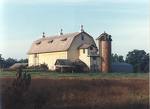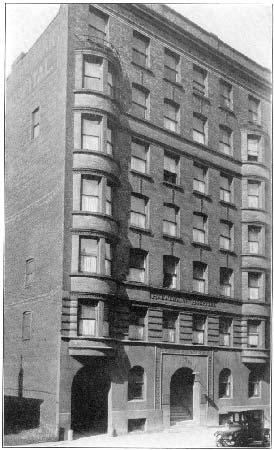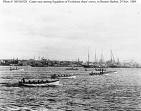The Paine Surname and Homeopathy
May 15, 2008
 The Paine surname gave us eight jobbing
homeopaths; a homeopathic surgeon; the Vice President of the
Northwestern Homeopathic Medical
Association;
the
President
of the Homoeopathic Medical Society of the State of New
York
and Vice
President
of the Albany County Homeopathic Medical
Society;
a
Secretary
of the New York Homeopathic Medical
College and the Homoeopathic
Medical Society of the State of New York and
Secretary and
Treasurer
of the Oneida County Homeopathic Medical
Society;
a
President
of the Oneida County Homeopathic Medical
Society;
a Resident Physician of Hahnemann
Hospital; and
an orthodox physician who converted to Eclectic Medicine and became the
editor of _The Eclectic Medical Journal of
Philadelphia_.
The Paine surname gave us eight jobbing
homeopaths; a homeopathic surgeon; the Vice President of the
Northwestern Homeopathic Medical
Association;
the
President
of the Homoeopathic Medical Society of the State of New
York
and Vice
President
of the Albany County Homeopathic Medical
Society;
a
Secretary
of the New York Homeopathic Medical
College and the Homoeopathic
Medical Society of the State of New York and
Secretary and
Treasurer
of the Oneida County Homeopathic Medical
Society;
a
President
of the Oneida County Homeopathic Medical
Society;
a Resident Physician of Hahnemann
Hospital; and
an orthodox physician who converted to Eclectic Medicine and became the
editor of _The Eclectic Medical Journal of
Philadelphia_.
 A H Paine Surgeon at ‘The
Homeopathic Hospital…’ 1920 mentioned in The Kodak
Magazine.
A H Paine Surgeon at ‘The
Homeopathic Hospital…’ 1920 mentioned in The Kodak
Magazine.
 Bartlett
L Paine was instrumental in the formation of the Northwestern
Homeopathic Medical
Association:
Bartlett
L Paine was instrumental in the formation of the Northwestern
Homeopathic Medical
Association:
This society originated with the homeopathic physicians of the western part of Iowa, who were placed at great inconvenience in attending the Iowa State Association, which was then held in the extreme eastern portion of the State.
Realizing the importance of some institution of the kind, the idea was conceived by a number of them, of forming an association of their own, composed of physicians living in the western part of Iowa and also those in the eastern part of the State of Nebraska, who might wish to avail themselves of its membership.
Those leading in this idea were, Drs. W. D. Stillman, of Council Bluffs; P. W. Poulson, T. H. Bragg, Allen Corson Cowperthwaite, of Lincoln, B. L. Paine, of Lincoln, and C. L. Hart, of Iowa.
The Northwestern Homeopathic Medical Association.—This society originated with the homeopathic physicians of the western part of Iowa, who were placed at great inconvenience in attending the Iowa State Association, which was then held in the extreme eastern portion of the State.
Realizing the importance of some institution of the kind, the idea was conceived by a number of them, of forming an association of their own, composed of physicians living in the western part of Iowa and also those in the eastern part of the State of Nebraska, who might wish to avail themselves of its membership.
The organization took place in 1877, at the city of Council Bluffs, Iowa. The society meets once in each year, at such place as the wishes and convenience of the members suggest.
The next meeting will be held in the city of Lincoln, Neb., on the fourth Wednesday of May, 1882. Officers for the association are elected at each annual convention, and at the last meeting the following were chosen for the ensuing year. President, W. H. Parsons, of Glenwood, Iowa; Vice-President, B. L. Paine, of Lincoln, Neb.; Secretary and Treasurer; W. D. Stillman, Council Bluffs, Iowa; Censors, Drs. P. J. Montgomery, B. L. Paine, P. W. Poulson, O. S. Wood, T. H. Bragg.
This society, like all similar ones, has for its aim the mutual improvement of its membership in that branch of the medical science to which they belong, the promotion of acquaintance of the members of the profession with each other, and the general advancement of the interest of the homeopathic system of medicine.
B L Paine was also a member of The Nebraska State Homeopathic Medical Society:
In September of 1873, a number of the members of the Homeopathic system of medicine inaugurated and established a society called the Nebraska State Homeopathic Medical Society. The leaders in this work were Drs. W. A. Burr, L. Walker, D. H. W. Corley, L. J. Bumstead, E. T. M. Hulbert, O. S. Wood, Allen Corson Cowperthwaite, J. A. Way. E. Lewis, and A. S. Wright.
The society was never incorporated, but steps are now being taken for that purpose. This being a State institution, its place of meeting is not confined to any one city, but meets annually, at such place as the members determine upon from one time to another. The election of officers takes place at every annual convention of the society.
The officers for 1882 are as follows: President, C. M. Dinsmore, M. D., Omaha; First Vice President, B. Carscaddan, M. D., York; Second Vice President, C. L. Hart, M. D. , Omaha; Secretary, L. J. Bumstead, M. D., Lincoln; Treasurer, F. B. Righter, M. D., Lincoln; Censors, B. L. Paine, M. D. Lincoln; G. E. Brown, M. D., Albion; Margaret L. Sabin, M. D., Lincoln.
 Charles E
Paine New York Homeopathic Medical
College Born 1876; Died Feb.
24, 1918 mentioned in Transactions by John Little
Moffat
Charles E
Paine New York Homeopathic Medical
College Born 1876; Died Feb.
24, 1918 mentioned in Transactions by John Little
Moffat
 Clarence Paine homeopath in
Atlanta mentioned in The Proceedings of the fourth quinquennial
session of the
International…_
_1891
Clarence Paine homeopath in
Atlanta mentioned in The Proceedings of the fourth quinquennial
session of the
International…_
_1891
 E D
Paine**
**mentioned in A Vital Force: Women in American
Homeopathy.**
**
E D
Paine**
**mentioned in A Vital Force: Women in American
Homeopathy.**
**
 Henry D
Paine - 1893 was born in Delhi, Delaware County New
York.
He studied under Dr. Hall and John Franklin
Gray
and practiced in Newburg on the Hudson, then in Albany and then New
York.
President
of the Homoeopathic Medical Society of the State of New
York
1864 and Vice
President
of the Albany County Homeopathic Medical
Society
1863.
Henry D
Paine - 1893 was born in Delhi, Delaware County New
York.
He studied under Dr. Hall and John Franklin
Gray
and practiced in Newburg on the Hudson, then in Albany and then New
York.
President
of the Homoeopathic Medical Society of the State of New
York
1864 and Vice
President
of the Albany County Homeopathic Medical
Society
1863.
Being one of the pioneers of homeopathy, Henry D Paine was attacked by allopaths, and Federal Vanderburg came in to defend him:
His letter to Judge Cowen, in defence of Dr. Henry D. Paine, then of Newburgh, N. Y., sets forth the claims of the new system upon the enlightened judgment of the age in a masterly manner. An Appeal for Homoeopathy; Or Remarks on the Decision of the Late Judge …
Henry D Paine was one of the founders and the Secretary of the American Institute of Homeopathy. He married Eliza Hale and they had two children, Frederick H Paine Lieutenant US Navy and a daughter F H Paine. He then married Lucy Gallup, daughter of Congressman Gallup of Albany and had a son Dr. Henry G Paine.
Henry D Paine was a homeopath and mesmerist in Albany County 1840 and was instrumental in establishing the New York Homeopathic Medical College in 1853. He was the editor of The Similibus 1872 in New York alongside Mrs. Carroll Dunham.
At a meeting of the New York State Homoeopathic Medical Society held at the Cooper Institute in New York, September 4, 1869, Dr. John Franklin Gray asked the Society to take measures for a more public commemoration of the labors of Dr. Hans Burch Gram.
Henry D Paine wrote An Address to the Homeopathic Physicians of the State of New York.
 **Horace
Marshfield
Paine **-
1904
homeopath in Albany in
1867
was appointed to a
committee
by the Homeopathic Medical Society of New York
to investigate the
Charter
of the Middletown Insane
Asylum,
alongside Samuel
Swan,
Alfred K Hills and Joseph Finch.
**Horace
Marshfield
Paine **-
1904
homeopath in Albany in
1867
was appointed to a
committee
by the Homeopathic Medical Society of New York
to investigate the
Charter
of the Middletown Insane
Asylum,
alongside Samuel
Swan,
Alfred K Hills and Joseph Finch.
Secretary of the New York Homeopathic Medical College, contributer to The North American Journal of Homeopathy 1861 and a member of the Oneida County Homeopathic Medical Society 1864, Secretary of the Homoeopathic Medical Society of the State of New York 1864, Secretary and Treasurer of the Oneida County Homeopathic Medical Society 1857.
Horace Marshfield Paine wrote _The History of Homoeopathy in Albany County, N. Y. Compirsing a Period of … _
 Howard S Paine mentioned in
The Hahnemannian
Monthly
1896 and The Directory of Homeopathic
Physicians
1925.
Howard S Paine mentioned in
The Hahnemannian
Monthly
1896 and The Directory of Homeopathic
Physicians
1925.
 John A Paine homeopath in Albany
mentioned in Pamphlets -
Homoeopathic_
_1848 was
President
of the Oneida County Homeopathic Medical
Society
1864.
John A Paine homeopath in Albany
mentioned in Pamphlets -
Homoeopathic_
_1848 was
President
of the Oneida County Homeopathic Medical
Society
1864.
From the Transactions of The Homoeopathic Medical Society of the State of New York 1887 - “He (?who) is the eldest son of the late Dr. John A. Paine, and is the only brother of Professor John A. Paine, of Tarrytown, NY…”
 Joseph P Paine mentioned in
The Proceedings of the fourth quinquennial session of the
International…_
_1891
Joseph P Paine mentioned in
The Proceedings of the fourth quinquennial session of the
International…_
_1891
 Josephine
Paine editor of The
Clinique
Illinois Homeopathic Medical
Association 1880.
Josephine
Paine editor of The
Clinique
Illinois Homeopathic Medical
Association 1880.
 N. Emmons Paine mentioned in the
Proceedings of the Massachusetts Homeopathic Medical
Society
1899, Practical Homeopathic
Therapeutics
1901 and The Directory of Homeopathic
Physicians
1925.
N. Emmons Paine mentioned in the
Proceedings of the Massachusetts Homeopathic Medical
Society
1899, Practical Homeopathic
Therapeutics
1901 and The Directory of Homeopathic
Physicians
1925.
 Richard Kendall
Paine 1841 - 1904
(1906)**
**
Richard Kendall
Paine 1841 - 1904
(1906)**
**
of Chicago, Ills., was born in the town of Orange, Vt., on the 5th of October, 1841. He is the son of William B. Paine, who started in life as a carpenter and wheelwright, which trades he followed for several years ; he then turned his attention to farming, in which pursuit he is at present engaged.
One of his brothers, Dr. Ezra Paine, is an allopathic physician practicing in Montpelier, Vt. ; and another, E. C. Paine, is the present Superintendent of Public Schools in Blue Earth county, Minn.
When Dr. Paine was in his tenth year his father removed to Fond du Lac, Wis., where the former received his primary education at the common schools of that town ; and he subsequently completed his literary studies at the Wayland University in Beaver Dam, Wis., and in the High School at Mankato, Minn.
In February, 1864, he enlisted in the 21st Regiment of Wisconsin Volunteers, but was so unfortunate, soon after going into camp, as to contract the measles. It was a very severe attack ; so much so that his life, at one time, was despaired of. After a slow recovery, he was detailed for duty at the Post Hospital, Madison, Wis., where he remained until his discharge in the following month of November.
His health being still impaired, he went to Minnesota in the spring of 1865, trusting that the change of air might be beneficial in restoring him to his former strength and vigor.
At that time he was entirely ignorant of the virtues of homœopathy. Treatment, according to the allopathic practice had failed to effect a cure in his case ; and in despair he resolved to try the “water cure” of Preissnitz (where Mary Sargeant Gove Nichols worked).
He read every work that he could procure on this subject, and applied the treatment there recommended to his own case. Receiving a decided benefit from the packing, etc., he advised other sufferers to try the remedy, and meeting with success, became for awhile the “water cure doctor” of the place.
But this mode of practice did not entirely satisfy him, and resolving to make medicine his profession, and having his attention now called to homœopathy, he entered the office of Dr. A. L. Dombery, of Mankato, Minn., to study the practice according to Hahnemann.
Dr. Dombery is a very learned and skilful physician, and having a large number of patients, he was enabled to impart much information to his pupil. He remained with his preceptor nearly three years, excepting during the winter season, when he was engaged in teaching school. While studying hydropathy he was elected Town Clerk of Rapidan by the Republican party, for the term of one year.
He next repaired to Chicago, and matriculated at Hahnemann College in the autumn of 1871. At the close of the lectures he received the appointment of Assistant Physician to Scammon (now Hahnemann Hospital) Hospital for one year. During this time he attended the lectures in the spring session of 1872, and also the entire winter course of 1872-‘73, graduating with the class of 1873.
Shortly after this event he was elected Resident Physician of Hahnemann Hospital, Nos. 287 and 289 Cottage Grove avenue, Chicago, Ills., which position he now holds. Dr. Paine is unmarried.
This is a bio. sketch from “History of Manitowoc County Wisconsin” by Dr. L. Falge, 1911-1912, v.2, p.22-25. With the sturdy characteristics of Puritan ancestry Dr. Richard K. Paine in the practice of medicine in Manitowoc, won for himself a creditable and notable position in his life work constituting an important chapter in the history of the medical profession here.
He always held to high ideals and he supplemented his thorough preparatory training by continuous study as the years passed on. He was born in Orange, Vermont, October 5, 1841, a son of William B. and Lovina (Averhill) Paine. He came of a family of English origin, tracing the lineage back to 1764 when Richard Paine, his great-grandfather, was born. Members of the family have been prominent in various walks of life since the Revolutionary war in which a number of the name actively participated.
When ten years of age Richard K. Paine was brought by his parents to the “unredeemed west,” and their home was established near Fond du Lac. The public schools of this locality furnished him with his early education and later he had the benefit of a course of instruction in Wayland Academy.
All business and personal considerations however, were put aside when in 1864 Dr. Paine enlisted for service as a member of Company F. 21st Regiment of Wisconsin Volunteers. Failing health however necessitated his discharge the following September and he was obliged to spend some time in the bracing air of Minnesota in order to recuperate.
In 1867 he took up the study of medicine under the direction of Dr. Patchen of Fond du Lac, but after a brief period he returned to Mankato, Minnesota,where he engaged in teaching school and at the same time continued his medical studies under Dr. A. L. Dornburg.
In 1871 he entered Hahnemann Medical College of Chicago and two years later he was graduated with the M. D. degree. During the succeeding two years he was one of the physicians at Hahnemann Hospital and he also pursued a course of lectures in the Chicago Medical College.
Throughout his life he remained a thorough and discriminating student of the science of medicine, constantly broadening his knowledge and promoting his efficiency by reading and investigation.
In 1874 he located at Manitowoc where for thirty years he engaged in a most successful practice. He was a member of the State Homeopathic Medical Society, the American Institution of Homeopathy and the Wisconsin League of Medical Licentiates, which latter society was organized at Milwaukee in 1900, its name being suggested by Dr. Paine.
On the 28th of October, 1874, Dr. Paine was united in marriage to Miss Elizabeth Patchen, a daughter of Dr. A. J. and Nancy (Kellogg) Patchen, both of whom are now deceased. Her father was at one time a prominent dentist of Manitowoc. Unto Dr. and Mrs. Paine were born two children, Richard A. and Bessie.
Fraternally Dr. Paine was connected with the Independent Order of Odd Fellows, the Modern Woodmen of America and the Royal Arcanum, and served as medical examiner for all three. He likewise belonged to the Grand Army of the Republic and thus maintained pleasant relations with his old comrades who wore the nation’s blue uniform. His life was indeed a busy and useful one and was fraught with many good deeds.
In addition to his practice he was a frequent contributor to leading medical journals and his writings attracted wide attention.
Death called him on the 14th of November, 1904, and in his passing his family lost a loving and devoted husband and father and the community a capable, successful physician and worthy citizen…
 S Paine homeopath in Atlanta in
1889.
S Paine homeopath in Atlanta in
1889.
 William E Paine
an orthodox doctor who converted to Eclectic
practice,
disgusted that “exclusivism in all its forms” was responsible for the
high mortality of patients.
William E Paine
an orthodox doctor who converted to Eclectic
practice,
disgusted that “exclusivism in all its forms” was responsible for the
high mortality of patients.
He wrote Treatise on the Principles and Practice of Medicine and Pathology: Diseases of Women and Children and Medical Surgery, which was sold in homeopathic pharmacies.
William E Paine was a member of the Massachusetts Homeopathic Medical Society. William E Paine sold a Charter to Hering’s College, and he was the editor of The Eclectic Medical Journal of Philadelphia.